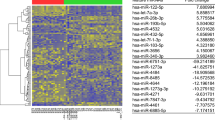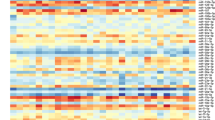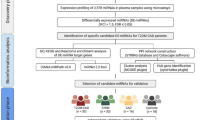Abstract
Aims
The aim of this study was to investigate a miRNA expression profile in type 1 diabetes mellitus (T1DM) patients with DKD (cases) or without this complication (controls).
Methods
Expression of 48 miRNAs was screened in plasma of 58 T1DM patients (23 controls, 18 with moderate DKD, and 17 with severe DKD) using TaqMan Low Density Array cards (Thermo Fisher Scientific). Then, five of the dysregulated miRNAs were selected for validation in an independent sample of 10 T1DM controls and 19 patients with DKD (10 with moderate DKD and 9 with severe DKD), using RT-qPCR. Bioinformatic analyses were performed to explore the putative _target genes and biological pathways regulated by the validated miRNAs.
Results
Among the 48 miRNAs investigated in the screening analysis, 9 miRNAs were differentially expressed between DKD cases and T1DM controls. Among them, the five most dysregulated miRNAs were chosen for validation in an independent sample. In the validation sample, miR-21-3p and miR-378-3p were confirmed to be upregulated in patients with severe DKD, while miR-16-5p and miR-29a-3p were downregulated in this group compared to T1DM controls and patients with moderate DKD. MiR-503-3p expression was not validated. Bioinformatic analyses indicate that the four validated miRNAs regulate genes from PI3K/Akt, fluid shear stress and atherosclerosis, AGE-RAGE, TGF-β1, and relaxin signaling pathways.
Conclusions
Our study found four miRNAs differentially expressed in patients with severe DKD, providing significant information about the biological pathways in which they are involved.




Similar content being viewed by others
References
Kanwar YS, Sun L, Xie P, Liu FY, Chen S (2011) A glimpse of various pathogenetic mechanisms of diabetic nephropathy. Ann Rev Pathol 6:395–423. https://doi.org/10.1146/annurev.pathol.4.110807.092150
Macisaac RJ, Ekinci EI, Jerums G (2014) Markers of and risk factors for the development and progression of diabetic kidney disease. Am J Kidney Dis 63(2 Suppl 2):S39–S62. https://doi.org/10.1053/j.ajkd.2013.10.048
Ritz E, Zeng XX, Rychlik I (2011) Clinical manifestation and natural history of diabetic nephropathy. Contrib Nephrol 170:19–27. https://doi.org/10.1159/000324939
Reddy MA, Tak Park J, Natarajan R (2013) Epigenetic modifications in the pathogenesis of diabetic nephropathy. Semin Nephrol 33(4):341–353. https://doi.org/10.1016/j.semnephrol.2013.05.006
Bassi R, Fornoni A, Doria A, Fiorina P (2016) CTLA4-Ig in B7-1-positive diabetic and non-diabetic kidney disease. Diabetologia 59(1):21–29. https://doi.org/10.1007/s00125-015-3766-6
Thomas MC (2016) Epigenetic mechanisms in diabetic kidney disease. Curr Diabetes Rep 16(3):31. https://doi.org/10.1007/s11892-016-0723-9
Nadkarni GN, Yacoub R, Coca SG (2015) Update on glycemic control for the treatment of diabetic kidney disease. Curr Diabetes Rep 15(7):42. https://doi.org/10.1007/s11892-015-0612-7
Glassock RJ (2010) Debate: CON position. Should microalbuminuria ever be considered as a renal endpoint in any clinical trial? Am J Nephrol 31(5):462–465. https://doi.org/10.1159/000313553 (discussion 466–467)
Esteller M (2011) Non-coding RNAs in human disease. Nat Rev Genet 12(12):861–874. https://doi.org/10.1038/nrg3074
Guay C, Regazzi R (2013) Circulating microRNAs as novel biomarkers for diabetes mellitus. Nat Rev Endocrinol 9(9):513–521. https://doi.org/10.1038/nrendo.2013.86
Weber JA, Baxter DH, Zhang S et al (2010) The microRNA spectrum in 12 body fluids. Clin Chem 56(11):1733–1741. https://doi.org/10.1373/clinchem.2010.147405
Seyhan AA, Nunez Lopez YO, Xie H et al (2016) Pancreas-enriched miRNAs are altered in the circulation of subjects with diabetes: a pilot cross-sectional study. Sci Rep 6:31479. https://doi.org/10.1038/srep31479
Feng Y, Yu X (2011) Cardinal roles of miRNA in cardiac development and disease. Sci China Life Sci 54(12):1113–1120. https://doi.org/10.1007/s11427-011-4257-8
Lin S, Gregory RI (2015) MicroRNA biogenesis pathways in cancer. Nat Rev Cancer 15(6):321–333. https://doi.org/10.1038/nrc3932
Assmann TS, Recamonde-Mendoza M, de Souza BM, Crispim D (2017) MicroRNA expression profiles and type 1 diabetes mellitus: systematic review and bioinformatics analysis. Endocr Connect. https://doi.org/10.1530/EC-17-0248
Harvey SJ, Jarad G, Cunningham J et al (2008) Podocyte-specific deletion of dicer alters cytoskeletal dynamics and causes glomerular disease. J Am Soc Nephrol: JASN 19(11):2150–2158. https://doi.org/10.1681/ASN.2008020233
Kato M, Natarajan R (2015) MicroRNAs in diabetic nephropathy: functions, biomarkers, and therapeutic _targets. Ann N Y Acad Sci 1353:72–88. https://doi.org/10.1111/nyas.12758
Pezzolesi MG, Satake E, McDonnell KP, Major M, Smiles AM, Krolewski AS (2015) Circulating TGF-beta1-regulated miRNAs and the risk of rapid progression to ESRD in type 1 diabetes. Diabetes 64(9):3285–3293. https://doi.org/10.2337/db15-0116
Chung AC, Yu X, Lan HY (2013) MicroRNA and nephropathy: emerging concepts. Int J Nephrol Renov Dis 6:169–179. https://doi.org/10.2147/IJNRD.S37885
von Elm E, Altman DG, Egger M, Pocock SJ, Gotzsche PC, Vandenbroucke JP, Initiative S (2008) The strengthening the reporting of observational studies in epidemiology (STROBE) statement: guidelines for reporting observational studies. J Clin Epidemiol 61(4):344–349. https://doi.org/10.1016/j.jclinepi.2007.11.008
Andrassy KM (2013) Comments on ‘KDIGO 2012 clinical practice guideline for the evaluation and management of chronic kidney. Dis Kidney Int 84(3):622–623. https://doi.org/10.1038/ki.2013.243
American Diabetes A (2015) (2) Classification and diagnosis of diabetes. Diabetes Care 38(Suppl 1):S8–S16. https://doi.org/10.2337/dc15-S005
Assmann TS, Brondani Lde A, Bauer AC, Canani LH, Crispim D (2014) Polymorphisms in the TLR3 gene are associated with risk for type 1 diabetes mellitus. Eur J Endocrinol/Eur Fed Endocr Soc 170(4):519–527. https://doi.org/10.1530/EJE-13-0963
Levey AS, Stevens LA, Schmid CH et al (2009) A new equation to estimate glomerular filtration rate. Ann Intern Med 150(9):604–612
Dweep H, Gretz N (2015) miRWalk2.0: a comprehensive atlas of microRNA-_target interactions. Nat Methods 12(8):697. https://doi.org/10.1038/nmeth.3485
Barutta F, Tricarico M, Corbelli A et al (2013) Urinary exosomal microRNAs in incipient diabetic nephropathy. PLoS One 8(11): e73798. https://doi.org/10.1371/journal.pone.0073798
DiStefano JK, Taila M, Alvarez ML (2013) Emerging roles for miRNAs in the development, diagnosis, and treatment of diabetic nephropathy. Curr Diabetes Rep 13(4):582–591. https://doi.org/10.1007/s11892-013-0386-8
Livak KJ, Schmittgen TD (2001) Analysis of relative gene expression data using real-time quantitative PCR and the 2(-Delta Delta C(T)) method. Methods 25(4):402–408. https://doi.org/10.1006/meth.2001.1262
Bustin SA, Benes V, Garson JA et al (2009) The MIQE guidelines: minimum information for publication of quantitative real-time PCR experiments. Clin Chem 55(4):611–622. https://doi.org/10.1373/clinchem.2008.112797
Chou CH, Chang NW, Shrestha S et al (2016) miRTarBase 2016: updates to the experimentally validated miRNA-_target interactions database. Nucleic Acids Res 44(D1):D239–D247. https://doi.org/10.1093/nar/gkv1258
Li JH, Liu S, Zhou H, Qu LH, Yang JH (2014) starBase v2.0: decoding miRNA-ceRNA, miRNA-ncRNA and protein-RNA interaction networks from large-scale CLIP-Seq data. Nucleic Acids Res 42(Database issue):D92–D97. https://doi.org/10.1093/nar/gkt1248
Vlachos IS, Paraskevopoulou MD, Karagkouni D et al (2015) DIANA-TarBase v7.0: indexing more than half a million experimentally supported miRNA:mRNA interactions. Nucleic Acids Res 43(Database issue):D153–D159. https://doi.org/10.1093/nar/gku1215
Agarwal V, Bell GW, Nam JW, Bartel DP (2015) Predicting effective microRNA _target sites in mammalian mRNAs. eLife. https://doi.org/10.7554/eLife.05005
Paraskevopoulou MD, Georgakilas G, Kostoulas N et al (2013) DIANA-microT web server v5.0: service integration into miRNA functional analysis workflows. Nucleic Acids Res 41:W169–W173. https://doi.org/10.1093/nar/gkt393 (Web Server issue)
Griffiths-Jones S, Saini HK, van Dongen S, Enright AJ (2008) miRBase: tools for microRNA genomics. Nucleic Acids Res 36(Database issue):D154–D158. https://doi.org/10.1093/nar/gkm952
Kanehisa M, Sato Y, Kawashima M, Furumichi M, Tanabe M (2016) KEGG as a reference resource for gene and protein annotation. Nucleic Acids Res 44(D1):D457–D462. https://doi.org/10.1093/nar/gkv1070
Yu G, Wang LG, Han Y, He QY (2012) clusterProfiler: an R package for comparing biological themes among gene clusters. Omics: J Integr Biol 16(5):284–287. https://doi.org/10.1089/omi.2011.0118
Team RC (2013) R: A language and environment for statistical computing. R Foundation for Statistical Computing, Vienna
Martino F, Lorenzen J, Schmidt J et al (2012) Circulating microRNAs are not eliminated by hemodialysis. PLoS One 7(6):e38269. https://doi.org/10.1371/journal.pone.0038269
Lorenzen JM, Thum T (2012) Circulating and urinary microRNAs in kidney disease. Clin J Am Soc Nephrol: CJASN 7(9):1528–1533. https://doi.org/10.2215/CJN.01170212
Baker MA, Davis SJ, Liu P et al (2017) Tissue-specific microRNA expression patterns in four types of kidney disease. J Am Soc Nephrol: JASN. https://doi.org/10.1681/ASN.2016121280
Zapata-Benavides P, Arellano-Rodriguez M, Bollain YGJJ et al (2017) Cytoplasmic localization of WT1 and decrease of miRNA-16-1 in nephrotic syndrome. BioMed Res Int 2017:9531074. https://doi.org/10.1155/2017/9531074
Neal CS, Michael MZ, Pimlott LK, Yong TY, Li JY, Gleadle JM (2011) Circulating microRNA expression is reduced in chronic kidney disease. Nephrology, dialysis, transplantation: official publication of the European Dialysis and Transplant Association. Eur Renal Assoc 26(11):3794–3802. https://doi.org/10.1093/ndt/gfr485
Kim JE, Jung HJ, Lee YJ, Kwon TH (2015) Vasopressin-regulated miRNAs and AQP2-_targeting miRNAs in kidney collecting duct cells. Am J Physiol Renal Physiol 308(7):F749–F764. https://doi.org/10.1152/ajprenal.00334.2014
Qu Y, Liu H, Lv X et al (2017) MicroRNA-16-5p overexpression suppresses proliferation and invasion as well as triggers apoptosis by _targeting VEGFA expression in breast carcinoma. Onco_target 8(42):72400–72410. https://doi.org/10.18632/onco_target.20398
Brosius FC, Coward RJ (2014) Podocytes, signaling pathways, and vascular factors in diabetic kidney disease. Adv Chronic Kidney Dis 21(3):304–310. https://doi.org/10.1053/j.ackd.2014.03.011
Kriegel AJ, Liu Y, Fang Y, Ding X, Liang M (2012) The miR-29 family: genomics, cell biology, and relevance to renal and cardiovascular injury. Physiol Genom 44(4):237–244. https://doi.org/10.1152/physiolgenomics.00141.2011
Qin W, Chung AC, Huang XR et al (2011) TGF-beta/Smad3 signaling promotes renal fibrosis by inhibiting miR-29. J Am Soc Nephrol: JASN 22(8):1462–1474. https://doi.org/10.1681/ASN.2010121308
Wang B, Komers R, Carew R et al (2012) Suppression of microRNA-29 expression by TGF-beta1 promotes collagen expression and renal fibrosis. J Am Soc Nephrol: JASN 23(2):252–265. https://doi.org/10.1681/ASN.2011010055
Lin CL, Lee PH, Hsu YC et al (2014) MicroRNA-29a promotion of nephrin acetylation ameliorates hyperglycemia-induced podocyte dysfunction. J Am Soc Nephrol: JASN 25(8):1698–1709. https://doi.org/10.1681/ASN.2013050527
Wilflingseder J, Sunzenauer J, Toronyi E et al (2014) Molecular pathogenesis of post-transplant acute kidney injury: assessment of whole-genome mRNA and miRNA profiles. PLoS One 9(8):e104164. https://doi.org/10.1371/journal.pone.0104164
Bang C, Batkai S, Dangwal S et al (2014) Cardiac fibroblast-derived microRNA passenger strand-enriched exosomes mediate cardiomyocyte hypertrophy. J Clin Investig 124(5):2136–2146. https://doi.org/10.1172/JCI70577
Ong J, Timens W, Rajendran V et al (2017) Identification of transforming growth factor-beta-regulated microRNAs and the microRNA-_targetomes in primary lung fibroblasts. PLoS One 12(9):e0183815. https://doi.org/10.1371/journal.pone.0183815
Jiao W, Leng X, Zhou Q et al (2017) Different miR-21-3p isoforms and their different features in colorectal cancer. Int J Cancer 141(10):2103–2111. https://doi.org/10.1002/ijc.30902
Jiang J, Lee EJ, Gusev Y, Schmittgen TD (2005) Real-time expression profiling of microRNA precursors in human cancer cell lines. Nucleic Acids Res 33(17):5394–5403. https://doi.org/10.1093/nar/gki863
Hua Z, Lv Q, Ye W et al (2006) MiRNA-directed regulation of VEGF and other angiogenic factors under hypoxia. PLoS One 1:e116. https://doi.org/10.1371/journal.pone.0000116
Xing Y, Hou J, Guo T et al (2014) microRNA-378 promotes mesenchymal stem cell survival and vascularization under hypoxic-ischemic conditions in vitro. Stem Cell Res Ther 5(6):130. https://doi.org/10.1186/scrt520
Funding
This study was supported by Grants from the Conselho Nacional de Desenvolvimento Científico e Tecnológico (Grant number: 482525/2013-4), Fundação de Amparo à Pesquisa do Estado do Rio Grande do Sul (Edital FAPERGS/CNPq PRONEX 12/2014: 16-2551-0000476-5), Coordenação de Aperfeiçoamento de Pessoal de Nível Superior, and Fundo de Incentivo à Pesquisa e Eventos at Hospital de Clínicas de Porto Alegre (Grant number: 14–0213). D. Crispim, L. H. Canani and T. S. Assmann are recipients of scholarships from CNPq.
Author information
Authors and Affiliations
Contributions
TSA designed the study, acquired and analyzed the data, and drafted the manuscript. MRM performed the bioinformatics analysis and reviewed the manuscript. ACB, MP, BT, and LHC interpreted the data and reviewed the manuscript. DC supervised the study, analyzed the data, and drafted the manuscript. All authors approved the final version.
Corresponding author
Ethics declarations
Conflict of interest
All authors declare no conflict of interest.
Ethical approval
All procedures performed in studies involving human participants were in accordance with the ethical standards of the Hospital de Clínicas de Porto Alegre research committee (number of approval 14–0213) and with the 1964 Helsinki Declaration and its amendments or comparable ethical standards.
Informed consent
Informed consent was obtained from all individual participants included in the study.
Additional information
Managed by Antonio Secchi.
Electronic supplementary material
Below is the link to the electronic supplementary material.
Rights and permissions
About this article
Cite this article
Assmann, T.S., Recamonde-Mendoza, M., Costa, A.R. et al. Circulating miRNAs in diabetic kidney disease: case–control study and in silico analyses. Acta Diabetol 56, 55–65 (2019). https://doi.org/10.1007/s00592-018-1216-x
Received:
Accepted:
Published:
Issue Date:
DOI: https://doi.org/10.1007/s00592-018-1216-x




